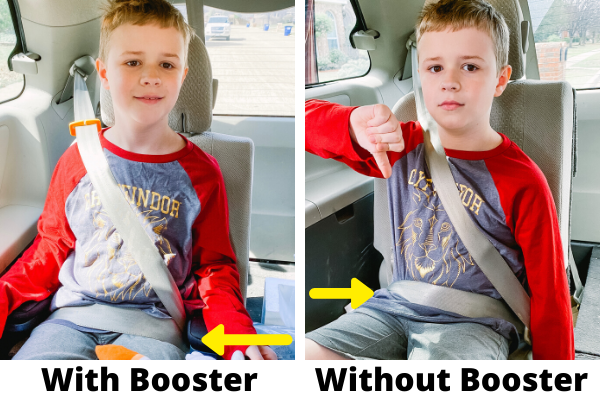Parenting is full of lots of milestones and graduating from using car seats is one of them. Once your child outgrows their car seat and doesn’t need another one, the feeling is very freeing!
Your job of worrying about keeping your kids safe in the car is OVER, right?! Actually, there’s still a lot more that moms need to know about protecting older kids in the car. As a Child Passenger Safety Technician, I’ve seen first hand that our older children are still very vulnerable.

Why does car seat safety matter?
Car crashes are a leading cause of death in children. Many of the deaths and injuries that happen in crashes every day are preventable. Knowing how to prevent them is key.
Some sobering facts from the Center for Disease Control and Prevention highlight areas for improvement:
- 49% of eight to 12 year olds who die in a crash are not buckled up.
- An estimated 46% of car seats and booster seats (59% of car seats and 20% of booster seats) are misused in a way that could reduce their effectiveness.
- Fatality rates in crashes are higher for children five and older than for younger children.
This is important to understand because all of the safety features that come with your vehicle won’t help (and sometimes can hurt) you and your children if you don’t follow safety best practices. Here are some of the most common areas that parents miss when they move into the older stages of parenting.
Booster Seats
Did you know that 90% of children move out of booster seats too soon? Children need to stay in a booster seat until they are approximately 4’9″ and pass The 5-Step Test. This is because adult seat belts are not designed for children. A booster is needed to correctly position the seat belt over the strongest parts of their body (low over the hips, and across the sternum and shoulders) rather than the soft tissue. Booster seat use reduces the risk for serious injury by 45%.

Note: A child’s bones are not as strong as an adult’s, which is why an ill-fitting seat belt on a child is a much greater concern than an ill-fitting seat belt on an adult.
Wearing The Seat Belt Properly
Like me, you might remember putting the seat belt behind your back as a child when it made you uncomfortable. This used to be commonplace but now we know this is extremely dangerous.
Wearing the seat belt improperly puts greater force onto a smaller area of your body versus spreading it out over a large area. It also increases the chances of the body rotating further forward which is associated with head injuries (see video here) and being ejected from the vehicle.

Airbags Safety and the Back Seat
The American Academy of Pediatrics recommends that children ride in the back seat until they are 13 years old. You might think this is overkill, but there’s a reason for it. And a big part of that reason is front airbags.
Just like all the other safety features, airbags are designed to save lives, but can become deadly if you don’t follow safety precautions. The airbags in the front seat are designed for adults and deploy in a fraction of a second with great speed. They can deploy in crashes where the driver is going as slow as eight miles per hour.
Airbags are designed to cushion large adults as they move forward with the rate of speed that the average adult would. Children are much smaller and lighter than adults, and they may be propelled forward and hit the airbag before it has completely inflated, impacting them at nearly 200 miles per hour rather than cushioning them.
Never, ever, ever put a rear-facing car seat in the front seat. The airbags can strike near their head and kill them.
If it is absolutely not possible to put your child in the back seat, move the passenger seat as far back away from the airbag as possible and ensure that they are using the proper child restraint for their age and height.

Car Safety in the Teenage Years
Once your child finally hits all of these other milestones, there’s still important conversations to have with them as teenagers. Teens are at greater risk of being involved in a motor vehicle crash than any other age group and have the lowest seat belt use rates. We need to continually emphasize the importance of wearing their seat belt always, and wearing it properly.
If someone else in the car is refusing to put on their seat belt, we need to let them know that it’s okay to speak up or refuse to drive or ride in a car with an unrestrained passenger. Unrestrained passengers are not just putting themselves at risk. They are putting everyone else in the car at risk, because they become a deadly projectile in a crash that can crush others around them.
We need to teach them to not be distracting to the person driving the car, and if they are the driver, how they can avoid distractions. Help them understand that while a car is an amazing thing, it can be a deadly thing if used improperly. Find some helpful tips about talking to your teens here.
The Bottom Line
No one should have to die in a car crash. Many of the deaths are preventable. We cannot control everything, but we can give ourselves and our family the best chance possible to survive.














Thanks for this info! It is very important to keep in our mind of this advises. I have little boys and all you say it is good to hear 😊❤️